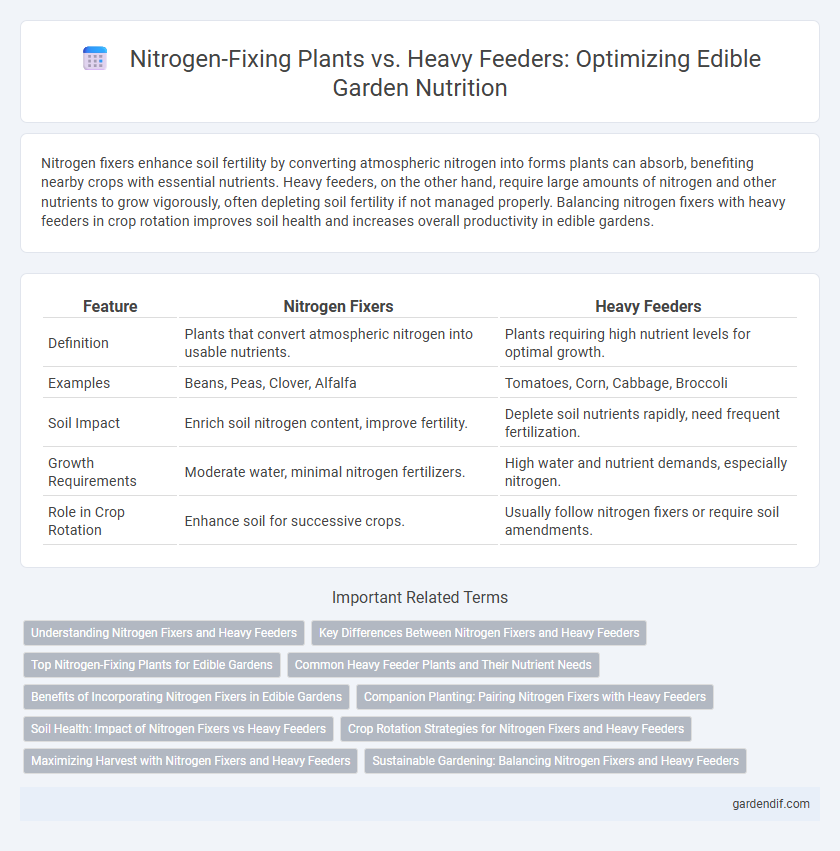
Nitrogen Fixers vs Heavy Feeders Illustration
Nitrogen fixers enhance soil fertility by converting atmospheric nitrogen into forms plants can absorb, benefiting nearby crops with essential nutrients. Heavy feeders, on the other hand, require large amounts of nitrogen and other nutrients to grow vigorously, often depleting soil fertility if not managed properly. Balancing nitrogen fixers with heavy feeders in crop rotation improves soil health and increases overall productivity in edible gardens.
Table of Comparison
| Feature | Nitrogen Fixers | Heavy Feeders |
|---|---|---|
| Definition | Plants that convert atmospheric nitrogen into usable nutrients. | Plants requiring high nutrient levels for optimal growth. |
| Examples | Beans, Peas, Clover, Alfalfa | Tomatoes, Corn, Cabbage, Broccoli |
| Soil Impact | Enrich soil nitrogen content, improve fertility. | Deplete soil nutrients rapidly, need frequent fertilization. |
| Growth Requirements | Moderate water, minimal nitrogen fertilizers. | High water and nutrient demands, especially nitrogen. |
| Role in Crop Rotation | Enhance soil for successive crops. | Usually follow nitrogen fixers or require soil amendments. |
Understanding Nitrogen Fixers and Heavy Feeders
Nitrogen fixers, such as legumes and clover, convert atmospheric nitrogen into a usable form, enriching soil fertility naturally. Heavy feeders like corn and tomatoes demand high nutrient levels, especially nitrogen, to support rapid growth and abundant yields. Understanding the balance between planting nitrogen fixers and heavy feeders optimizes soil health and crop productivity.
Key Differences Between Nitrogen Fixers and Heavy Feeders
Nitrogen fixers, such as legumes, convert atmospheric nitrogen into forms plants can absorb, enriching soil fertility naturally, while heavy feeders like corn and tomatoes rapidly consume large amounts of soil nutrients, necessitating frequent fertilization. Nitrogen fixers improve soil structure and reduce dependency on synthetic fertilizers, contrasting with heavy feeders that often deplete soil nutrients and require substantial nutrient replenishment. This fundamental difference affects crop rotation strategies, sustainability practices, and overall soil health management in agricultural systems.
Top Nitrogen-Fixing Plants for Edible Gardens
Top nitrogen-fixing plants for edible gardens include legumes such as peas, beans, and lentils, which enrich soil nitrogen levels naturally. These plants form symbiotic relationships with Rhizobium bacteria, converting atmospheric nitrogen into a bioavailable form that benefits heavy feeders like tomatoes and corn. Integrating nitrogen fixers into crop rotations improves soil fertility and supports sustainable garden productivity.
Common Heavy Feeder Plants and Their Nutrient Needs
Common heavy feeder plants such as tomatoes, corn, and broccoli demand high levels of nitrogen, phosphorus, and potassium to support their vigorous growth and fruit production. These crops often deplete soil nutrients rapidly, necessitating regular fertilization and soil amendment for sustained productivity. Nitrogen fixers like beans and peas enrich the soil by converting atmospheric nitrogen into usable forms, reducing the need for synthetic nitrogen inputs in mixed planting systems.
Benefits of Incorporating Nitrogen Fixers in Edible Gardens
Nitrogen fixers, such as beans, peas, and clover, enrich the soil by converting atmospheric nitrogen into a form easily absorbed by plants, significantly reducing the need for synthetic fertilizers in edible gardens. Incorporating nitrogen fixers improves soil fertility, enhances plant growth, and increases crop yields for heavy feeders like corn, tomatoes, and spinach. This natural nutrient cycling promotes sustainable gardening practices while supporting healthy, nutrient-dense produce.
Companion Planting: Pairing Nitrogen Fixers with Heavy Feeders
Pairing nitrogen fixers like clover or beans with heavy feeders such as corn or tomatoes enhances soil fertility by naturally increasing nitrogen levels, reducing the need for synthetic fertilizers. Heavy feeders benefit from the nitrogen enriched environment created by fixers, promoting robust growth and higher yields. This symbiotic companion planting strategy improves nutrient cycling and supports sustainable, organic edible gardens.
Soil Health: Impact of Nitrogen Fixers vs Heavy Feeders
Nitrogen fixers like legumes enrich soil by converting atmospheric nitrogen into bioavailable forms, enhancing soil fertility and reducing the need for synthetic fertilizers. Heavy feeders such as corn and cabbage deplete soil nutrients rapidly, often leading to nutrient imbalances and soil degradation if crop rotation or supplementation is not practiced. Integrating nitrogen fixers with heavy feeders in crop rotations improves soil health, promotes sustainable nutrient cycling, and boosts long-term agricultural productivity.
Crop Rotation Strategies for Nitrogen Fixers and Heavy Feeders
Effective crop rotation strategies balance nitrogen fixers like legumes with heavy feeders such as corn and tomatoes to maintain soil fertility and optimize yield. Nitrogen-fixing plants, including peas and beans, enrich the soil by converting atmospheric nitrogen into bioavailable forms, reducing the need for synthetic fertilizers. Alternating these with heavy feeders ensures nutrient depletion is minimized while promoting sustainable soil health and improved crop productivity.
Maximizing Harvest with Nitrogen Fixers and Heavy Feeders
Integrating nitrogen fixers such as beans and peas with heavy feeders like corn and tomatoes enhances soil fertility by naturally replenishing nitrogen, thereby maximizing overall crop yield. Rotating these plant types optimizes nutrient availability, reduces synthetic fertilizer dependency, and supports sustainable edible gardening practices. Strategic intercropping of nitrogen-fixing legumes alongside nutrient-demanding vegetables promotes healthier plants and increased harvest size.
Sustainable Gardening: Balancing Nitrogen Fixers and Heavy Feeders
In sustainable gardening, balancing nitrogen fixers such as peas and beans with heavy feeders like tomatoes and corn optimizes soil fertility and plant health. Nitrogen fixers enrich the soil by converting atmospheric nitrogen into a usable form, reducing the need for synthetic fertilizers, while heavy feeders deplete nitrogen rapidly, necessitating careful crop rotation or companion planting. This synergy promotes a self-sustaining ecosystem, enhances yield, and supports long-term soil vitality.
Nitrogen Fixers vs Heavy Feeders Infographic

 gardendif.com
gardendif.com